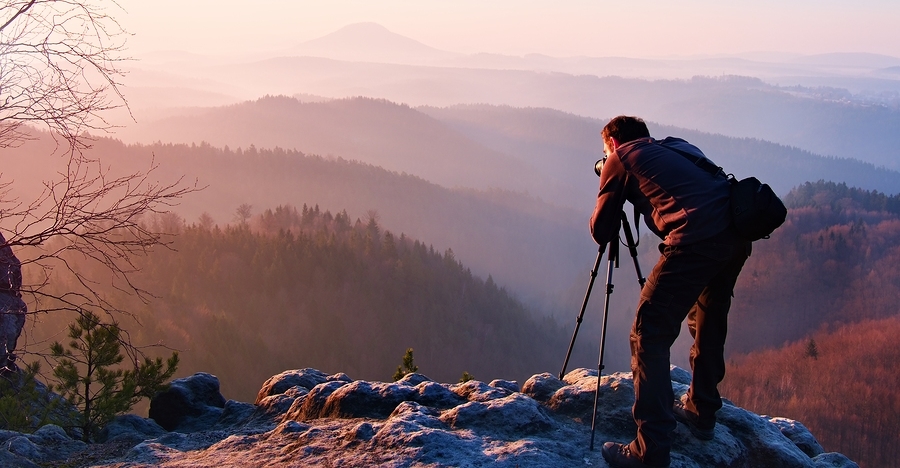Believe it or not, the “nifty-fifty”, 50mm prime lens actually makes an awesome lens for landscape portraiture.
I know, I know – it’s a portrait lens. Or a street photography lens. Or the perfect lens for your candid travel photography. And yes, it is all of that but you should definitely give it a try as a landscape lens, too. Here are a couple of good reasons why.
Quality
Landscapes usually require very good sharpness, and the 50mm prime lenses excel at that. No extra moving parts normally required for varied focal lengths (zooms) mean a crisper, sharper result. As with most lenses, its sweet spot isn’t wide open, but more in the f/4 to f/5.6 range. Even narrower apertures will still yield excellent results.
No Wide Angle…or Can There Be?
Of course there can! The 50mm gives you a gentle push into playing around with some panoramic shots. Three, four, five, or more shots can be stitched into a flattering wide angle composite, sometimes with even more dramatic results than a single wide angle shot.
Lightweight is King
If you’re serious about landscape photography, you’re probably already lugging around a considerable amount of gear; camera bodies, other lenses (you don’t go out with just one lens, do you?), tripods – the list goes on. The last thing you need are more heavy lenses when you’re out and about, right? Do you know what the Canon 50mm f/1.8 weighs? 4.6 ounces (130 g). It’s short, sweet, and light to boot.
Focus on What’s Important
We think of landscapes as sprawling, wide shots, that include many elements in one frame, but does it have to be that way? Can we not capture the beauty of the area around us, in a tighter package? The rolling hills and an interesting tree in an outdoor scene are more than enough to create a photo that provokes thought.
Read the full article over at Digital Photography School.
Source: Digital Photography School


the 50mm lens advice…. is this for a full frame or an APS-C. I have a Nikon D5200 and a 50mm f1.8 so it has a telephoto effect.
Both. Just remember that the 50 mm will increase when mounted on a cropped sensor camera.
I could not agree with this article more! The 50mm is the only lens I’ve ever used for the shots on my page, though I have used an array of lenses before. The 50mm has been my first lens I’ve tried and it’s proven itself to be true. In my honest opinion, I figure I don’t get the quality I’m personally looking for when I use a wide angle lens because the focus of the subject is very important to me. Feel free to check out my page here 🙂 :
https://www.facebook.com/JonathanMyersPhotography/
I have the Nikon 35mm f1.8 which equates to 52mm on APS-C. Wonderful little lens. Use in portrait mode and take 3-5 exposures that are stitched together for a wide angle landscape or pano.
Its a fantastic advice. Another advantage of doing composites in such way is that we can make gigantic prints later without worrying too much of image quality reduction. Another advantage also comes in night time starry landscape images when high ISOs are used. With composite technique grainy noise element becomes so small that noise is almost unnoticeable.Voila!! Feel free to check out –
https://www.facebook.com/thetaintedtripod
On an APSC senser camera the best and the sharpest is the 28mm equivalent which is around 42 to 44. I have to admit however that the sharpest I have for that is an old Konica Hexanon 28mm 3.5 from the 70’s. It’s detail is amazing…If you are using any lens (modern or otherwise) a Prime 28 mm on an APSC (around 42mm full frame equivalent) can not be beat….
Long telephotos can bring tremendous scenics. I have shots of
Palenque (Mexican ruins- shot in1974) thaT are spectacular. But ya gotta go get the picture, eveN if’s it from your LeicaIIIc
While I use my 20mm f2.8 and my 35mm 1.8 for some landscapes it all depends on the scene. Recently I was taking photographs of the Boston harbor skyline at night from a point across the harbor near Logan airport. The 20mm brought TOO much into the picture but my 50mm 1.4 was just right for the shot I wanted. I’ve also used a telephoto lens for some shots to take advantage of the compression of foreground and background. A 300mm lens on an full frame body can make the sun or the moon appear larger in the photo than a normal or wide angle lens adding impact to the image.